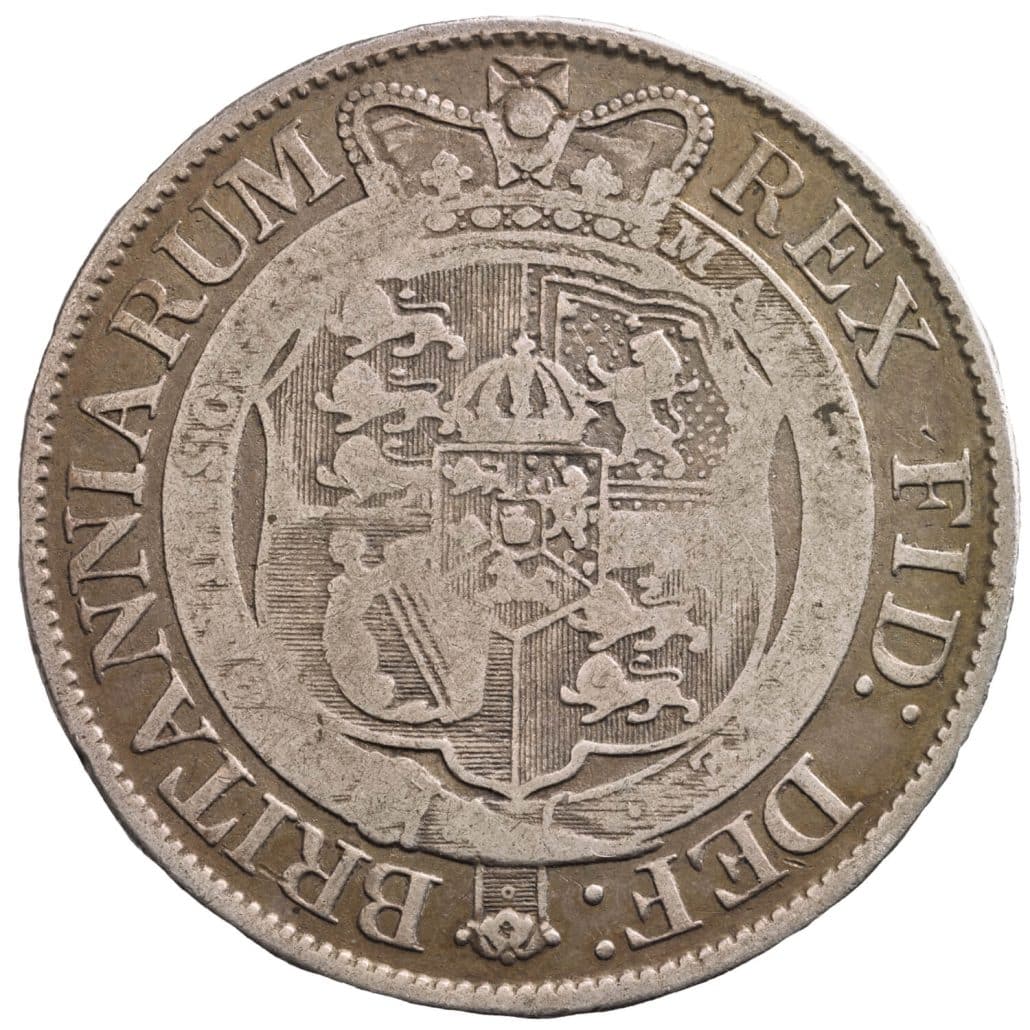Historical Significance
The George III Half-Crown Type II holds a revered place in the annals of British numismatics. Minted during the reign of King George III, this coin is more than just a piece of currency; it represents a pivotal era in British history. The period marked significant developments, both in the United Kingdom and globally, influencing the economic and social landscapes profoundly. Collectors and historians alike value this coin for its connection to the era of British expansion and industrial revolution, making it a significant artifact for those interested in the rich tapestry of England’s past.
Design and Features
The design of the George III Half-Crown Type II is distinguished by its intricate detailing, which reflects the artistic standards of the time. The obverse of the coin features the robust profile of King George III, symbolizing his strong and enduring reign. The reverse, meanwhile, is adorned with the crowned shield of the Royal Arms, encapsulating the heraldic symbols of England, Scotland, and Ireland. This design not only underscores the coin’s aesthetic appeal but also its symbolic representation of the unity and strength of the British Isles under George III’s rule.

Years of Issuance
The George III Half-Crown Type II was issued during a particularly tumultuous period of British history, spanning from the late 18th century into the early 19th century. These years were marked by various significant events, including numerous military engagements and the ongoing effects of the Industrial Revolution. The issuance of this coin through these critical years further adds to its historical value, offering a tangible connection to a transformative period in British history. Collectors often seek out specific years within this range, as variations in minting can reflect changes in technology and shifts in political power during George III’s long reign.
Rarity and Value Factors
Factors Affecting Rarity
The rarity of the George III Half-Crown Type II is influenced by several key factors. Firstly, the total number of coins minted during its production years significantly impacts its scarcity. Coins from years with lower mintages are typically rarer and thus more sought after. Additionally, the survival rate of these coins plays a crucial role. Many coins may have been lost or melted down over the centuries, reducing the number available to collectors today.
Market Trends and Value Fluctuations
The value of the George III Half-Crown Type II is not static and fluctuates based on current market trends. Factors such as the overall demand for British coins, particularly those from the era of King George III, influence its market value. Economic conditions, collector interest, and historical significance also play significant roles in determining its worth. Coins in superior condition, especially those with minimal wear and exceptional detailing, typically command higher prices in the market, reflecting their rarity and desirability among collectors.
How to Determine Authenticity
Key Features to Look For
When assessing the authenticity of a George III Half-Crown Type II, specific features must be scrutinized. Firstly, the weight and dimensions of the coin should match historical specifications, as deviations can indicate a counterfeit. The quality of the metal and the precision of the strike are also telling; genuine coins will have a consistent alloy composition and sharp, well-defined imagery reflective of the minting technology of the period.
Common Reproductions and Forgeries
Reproductions of the George III Half-Crown Type II typically lack the fine details of the original coins. Forgeries may present anomalies in letter spacing, depth of relief, and edge design, which are not consistent with genuine specimens. Collectors should be wary of coins that show signs of modern machining or those that have details that appear overly crisp without corresponding wear, suggesting artificial aging.
Resources for Coin Verification
For thorough verification, collectors are advised to consult with reputable numismatic experts or utilize services from recognized coin grading agencies. These professionals use advanced tools, including magnification devices and chemical testing, to determine the authenticity of a coin. Additionally, reference to auction house catalogs and numismatic databases can provide comparative examples of verified George III Half-Crown Type II coins, aiding in the authentication process.
Conclusion
Throughout this exploration of the George III Half-Crown Type II, we’ve journeyed through the coin’s historical context, aesthetic attributes, and the varied years of its issuance, which together amplify its desirability among collectors and historians. The significance of this coin transcends mere monetary value; it embodies the monumental shifts within British governance, society, and the broader spectrum of the industrial revolution. As such, the rarity and worth of the George III Half-Crown Type II are deeply interlinked with these factors, underscoring the importance of understanding its place in history to truly appreciate its value.
In assessing the rarity and potentially high value of the George III Half-Crown Type II, it is imperative to consider the layered significance that this coin holds. The evaluation of its worth is not merely a function of its scarcity but is also enriched by the historical narratives and the artistic craftsmanship it represents. This coin, as a relic of the past, provides a tangible connection to the transformative era of George III’s reign, making it a prized possession for those captivated by the legacy of British numismatics. For collectors and enthusiasts, the pursuit of such a piece goes beyond monetary evaluation, venturing into the realm of preserving a piece of British history.

